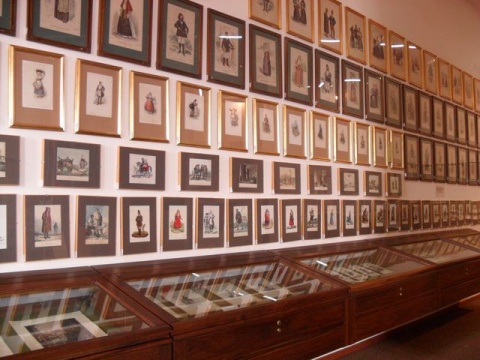Collection of Sardinian art and handicrafts, featuring paintings, maps, traditional clothing, carpets, rosaries, jewellery and silverware.
The Collection is housed on the ground floor of the building that previously housed the Tridentine Seminary. The palace was built by the military Count Saverio Belgrano Famolasco during the 17th century. The collection consists of about 900 pieces, and was donated to the University in 1980 by Dr. Luigi Piloni Bogliolo dell'Arme. After the works were completed by the architect De Plano, it was inaugurated in November 1984.
Piloni, our illustrious countryman, created the collection not only thanks to its economic resources, but also through his good taste, deep culture and a little 'luck', which have been essentials during his life in order to find on the market unique artworks, and unique and valuable collections.
Except for the entrance hall, the exhibition encompasses six rooms in which are exhibited some prints of art, history and culture of Sardinian famous people. Then, on a display case there are some publications donated by Piloni.
In the first room, dedicated to the religious iconography, there are two major findings of the collection, two parts of the altarpiece dating back to the 1500's. One, is a table of Michele Cavaro, illustrating Santa Chiara, from the altarpiece of the Madonna of Bonaria, and the other is of Antiochus Mainas depicting the Deposition of Christ, from the altarpiece of the Council House of Oristano.
In the second room there are 32 original paintings of Philippine della Marmora, nephew of the General Alberto Ferrero della Marmora. These pieces, that provide an overview of Sardinian locations, hold a high documentary value if not artistic, dating back to the period 1852-1860.
In the third room there are 1900s works of most famous Sardinian painters and artists, featured in oil paintings, watercolors, paints ( A. Ballero, G. Biasi, C. Cabras, S. Dessy, M. Sironi, F. Figari, F. Melis Marini, M. Delitala, C. Floris, G. Ciusa Romagna, T. Scano, A. Sassu ), as well as some other foreign artists, among which R. Locatelli and G. Sciuti.
In the fourth room there are jewels of traditional Sardinian silverware, considered "clothing" and including: rosaries of 18th-19th century, necklaces, pendants, reliquaries, spuligadentes, ganceras, buttons and charms.
In the fifth room there are more than two hundred island views, including lithographs, watercolors, paints and inks, some of which are uncommon and authentic.
In the sixth room, the largest, which is located on the left side of the entrance and used as auditorium during the Tridentine Seminary, we can admire: forty elaborate textiles named bertulas and originating from Campidano, strips called "coberi bancu " and "coberi cascia", a bedspread and three carpets, one from Oristano with a particularity "sa mustra". There are also artifacts dating back to 1700s, 1800s and ( as two rare " tapinu de mortu " ) 1900s.
The hall houses a series of traditional costumes prints, 25 lithographs of Pittaluga, 10 chromolithographs of Enrico Costa, 43 color prints of Dalsani (G. Ansaldi ), 13 lithographs of Martinelli, 49 lithographs of Baldassarre.
There is also a fine collection of over one hundred maps and pilot books, including some handwritten, dating back from Tolomeo copies to 1939, with the folk tourist map of V. Nicouline published by De Agostini.
Collezione Sarda "Luigi Piloni"
Collezione Sarda "Luigi Piloni"
via Università, 32
City
CagliariAdd new review
Your review will be visible after approval by the editors
To post a review you must be an authenticated user.
Log in with Social Login
